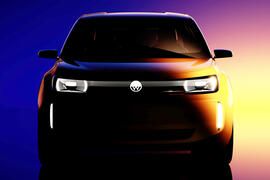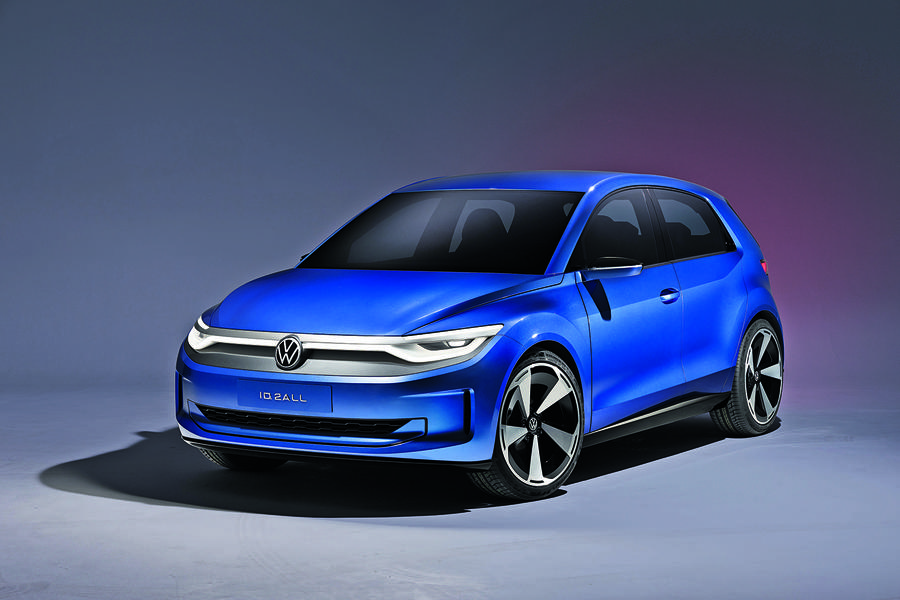 Bold new look for Volkswagen's long-awaited 'ID 1' entry EV, due in showrooms in 2027
Bold new look for Volkswagen's long-awaited 'ID 1' entry EV, due in showrooms in 2027
Volkswagen will reveal a new concept next month which previews a £17k electric car to succeed the Up.
The new entry-level model, to be previewed with a show car early next month, is due to enter production in 2027 with a base price of "about €20,000", Volkswagen said, making it "attractive for a wide variety of of user groups".
Known as the ID 1, the new Up successor is expected to share its fundamental platform with the larger, Volkswagen Polo-sized ID 2 – a shortened 'Entry' version of the Volkswagen Group's modular MEB architecture – but no technical details have yet been confirmed.
The first preview image suggests the new city car will have chunky, upright proportions and a distinctive new visage incorporating Volkswagen's new-look LED lighting signatures.
Volkswagen CEO Thomas Schäfer celebrated the new car's unveiling as a pivotal moment for the company: "An affordable, high-quality, and profitable electric Volkswagen from Europe for Europe – that's the Champions League of automotive engineering!”
It is not yet confirmed whether the new entry model would be built in Spain by the Volkswagen Group, alongside the ID 2 and its 'ID 2 X' crossover sibling, the Skoda Epiq compact SUV and the more sporting Cupra Raval.

Volkswagen's technical development boss Kai Grünitz has previously suggested the new entry model will be an obvious successor to the successful Up city car in its conception, and will share some design elements and attributes.
“The ‘ID 1’ will be close to the Up regarding the usage of that car," he said. "There aren't so many possibilities to design a small vehicle for cities in terms of what it looks like. It will be a car that fits into the Volkswagen brand design DNA and functionality DNA but at a lower price.”
Grunitz stopped short of categorically confirming the return of the Up badge, but Volkswagen places great value on its longest-running and most successful names. Golf, Passat and Tiguan are all due to be retained in the EV era, with the suggestion that the brand’s numerical naming strategy for its ID EVs could be retired.
Grünitz outlined the importance of bringing such a car to market: “You need a smaller car that’s affordable for the broader customer base. That’s why we’re going for €25,000 for the ID 2all and we're invested in the development phase for a vehicle below €20,000 - that’s Volkswagen.
“We have to go in that direction to convince our customers that EV is the right way.”
“You need a car that really fits the customer demands in that price class. You don’t need high-end technology within these cars," said Grünitz.
“Maybe you could bring your own device into this car instead of having a huge infotainment system, or something like that,” he added, hinting at the possibility for the Up replacement to feature a smartphone cradle in place of a touchscreen, like the previous car.
“It has to be tailored to the customer group,” he said, adding that the focus will instead be on making it “bigger inside than outside”, with effective use of space and a range of innovative storage solutions.
Neither will the final car be equipped with 200kW fast-charging capacity or a battery that allows it to travel long distances because it's envisioned as a pure city car, “not a car for driving thousands of kilometres on the highway”.
The Volkswagen e-Up, retired in 2023 along with the petrol Up as production came to a close in Bratislava, Slovakia, had a claimed range of 161 miles and could charge at a maximum speed of 37kWh.
Asked by Autocar whether the Up’s replacement can be produced profitably, Grünitz suggested that it might not need to generate huge margins in its own right but could rather serve as a ‘loss leader’ by introducing younger users to the VW EV line-up.
“Should it be a vehicle that is profitable on its own, or should we look for a vehicle that might be for first users? I started with a Polo when I was 18 years old. I got in touch with the VW family, jumped into a Golf and never left the Volkswagen family. It’s really important to have a vehicle for first-car users," Grünitz said.
“There's also the possibility to earn money with more expensive cars,” he said, suggesting margins from larger cars could be sufficient to support production of a less profitable model.